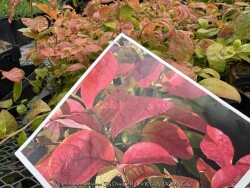

Sky Dew Gold ornamental blueberry has such appealing bright gold foliage that the flowers and berries are almost an afterthought. Its display gets even more interesting as the summer nights start to cool, and the golden foliage starts taking on rich hues of orange and red. The effect is simply thrilling; seeing something so colorful and cheerful puts a smile on your face. Highbush Blueberry, (Vaccinium corymbosum) needs rich organic acidic soil. You can easily create this by adding a mound of ground up leaves from your fall cleanup each year.
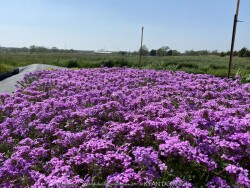

***Description for this perennial available with future update!***Native Rose Verbena / Glandularia (flat), is also known as Verbena / Glandularia canadensis


***Description for this perennial available with future update!***Native Rose Verbena / Glandularia, is also known as Verbena / Glandularia canadensis
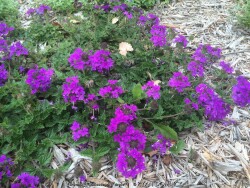

***Description for this plant available with future update!*** Verbena canadensis 'Homestead Purple' is also known as Homestead Purple Verbena.


***Description for this perennial available with future update!*** Vernonia baldwinii is also known as Western Ironweed.


***Description for this perennial available with future update!*** Vernonia baldwinii is also known as Western Ironweed.
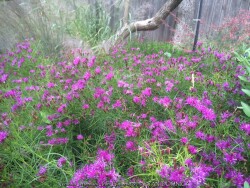

Narrow-leaf Ironweed (Vernonia lettermannii) is a relatively new plant to horticulture; originally discovered in Arkansas along gravel stream beds in the wild. The Iron Butterfly cultivar (Vernonia lettermannii 'Iron Butterfly') is a dwarf compact cultivar introduced by Dr. Allan Armitage at the University of Georgia. This is a true four-seasons perennial that belongs in almost every perennial garden. In the spring, narrow dark green foliage resembling Amsonia hubrichtii creates a compact shrub-like appearance. The growth is so dense that no weeds have a chance of invading a mature stand of plants. By mid to late summer, gorgeous deep purple fine-textured flowers cover the plant for 4-6 weeks. Butterflies, bees, and other pollinators flock to the occasion. Following the bloom, the flower stocks are sturdy and hold up very well for fall and winter interest. The flowers themselves produce mostly non-viable seed and cling to the plant creating a silvery shine whenever sunlight hits it. This can be very useful and dried flower arrangements as well as winter interest gardens. At some point in the winter, all top growth will need to be cut back as this is the only maintenance required. Despite being native to gravel and sand bars along rivers, Iron butterfly Vernonia surprisingly can handle very dry clay, gravelly, or sandy soils along with short periods of flooding. Permanently wet soil is not favored but it can handle the upper portions of a rain garden. Iron butterfly has only one pest problem and that is rabbits! If rabbits are an issue, just put a bowl-shaped chicken wire cage around the plants for the first year. By year #2, the rapidly growing foliage will outgrow any detrimental rabbit browsing. This is definitely one of the most adapted landscape plants in Kansas zone 6a with no problems with heat or cold, dry or wet! It's hard to imagine a perennial garden without this plant!
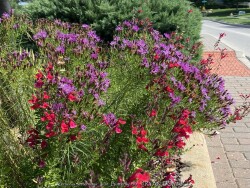

Narrow-leaf Ironweed (Vernonia lettermannii) is a relatively new plant to horticulture; originally discovered in Arkansas along gravel stream beds in the wild. The Iron Butterfly cultivar (Vernonia lettermannii 'Iron Butterfly') is a dwarf compact cultivar introduced by Dr. Allan Armitage at the University of Georgia. This is a true four-seasons perennial that belongs in almost every perennial garden. In the spring, narrow dark green foliage resembling Amsonia hubrichtii creates a compact shrub-like appearance. The growth is so dense that no weeds have a chance of invading a mature stand of plants. By mid to late summer, gorgeous deep purple fine-textured flowers cover the plant for 4-6 weeks. Butterflies, bees, and other pollinators flock to the occasion. Following the bloom, the flower stocks are sturdy and hold up very well for fall and winter interest. The flowers themselves produce mostly non-viable seed and cling to the plant creating a silvery shine whenever sunlight hits it. This can be very useful and dried flower arrangements as well as winter interest gardens. At some point in the winter, all top growth will need to be cut back as this is the only maintenance required. Despite being native to gravel and sand bars along rivers, Iron butterfly Vernonia surprisingly can handle very dry clay, gravelly, or sandy soils along with short periods of flooding. Permanently wet soil is not favored but it can handle the upper portions of a rain garden. Iron butterfly has only one pest problem and that is rabbits! If rabbits are an issue, just put a bowl-shaped chicken wire cage around the plants for the first year. By year #2, the rapidly growing foliage will outgrow any detrimental rabbit browsing. This is definitely one of the most adapted landscape plants in Kansas zone 6a with no problems with heat or cold, dry or wet! It's hard to imagine a perennial garden without this plant!
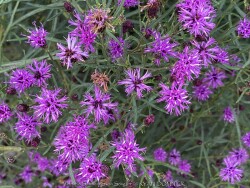

***Description for this perennial available with future update!*** Vernonia lettermannii 'Summers Swan Song' is also known as Summers Swan Song Narrow-leaf Ironweed >>>>> Narrow-leaf Ironweed (Vernonia lettermannii) is a relatively new plant to horticulture; originally discovered in Arkansas along gravel stream beds in the wild. The Iron Butterfly cultivar (Vernonia lettermannii 'Iron Butterfly') is a dwarf compact cultivar introduced by Dr. Allan Armitage at the University of Georgia. This is a true four-seasons perennial that belongs in almost every perennial garden. In the spring, narrow dark green foliage resembling Amsonia hubrichtii creates a compact shrub-like appearance. The growth is so dense that no weeds have a chance of invading a mature stand of plants. By mid to late summer, gorgeous deep purple fine-textured flowers cover the plant for 4-6 weeks. Butterflies, bees, and other pollinators flock to the occasion. Following the bloom, the flower stocks are sturdy and hold up very well for fall and winter interest. The flowers themselves produce mostly non-viable seed and cling to the plant creating a silvery shine whenever sunlight hits it. This can be very useful and dried flower arrangements as well as winter interest gardens. At some point in the winter, all top growth will need to be cut back as this is the only maintenance required. Despite being native to gravel and sand bars along rivers, Iron butterfly Vernonia surprisingly can handle very dry clay, gravelly, or sandy soils along with short periods of flooding. Permanently wet soil is not favored but it can handle the upper portions of a rain garden. Iron butterfly has only one pest problem and that is rabbits! If rabbits are an issue, just put a bowl-shaped chicken wire cage around the plants for the first year. By year #2, the rapidly growing foliage will outgrow any detrimental rabbit browsing. This is definitely one of the most adapted landscape plants in Kansas zone 6a with no problems with heat or cold, dry or wet! It's hard to imagine a perennial garden without this plant!


***Description for this perennial available with future update!*** Vernonia baldwinii is also known as Western Ironweed.
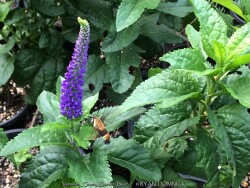

***Description for this perennial available with future update!***Sunny Border Blue Veronica, is also known as Veronica 'Sunny Border Blue'
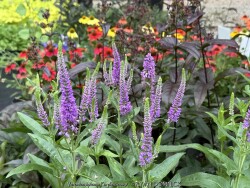

***Description for this perennial available with future update!*** Veronica spicata 'Purpleicious' is also known as Purpleicious Veronica.
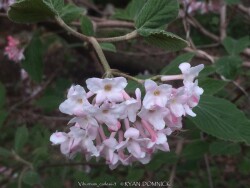

***Shrub descriptions available with future update!*** Viburnum carlesii is also known as Korean Spice Pink Flowering Viburnum.
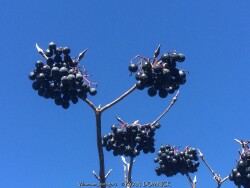

***Tree descriptions available with future update!*** Viburnum lentago is also known as Nannyberry Viburnum / Edible Tree Viburnum
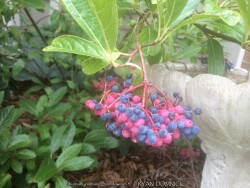

***Shrub descriptions available with future update!*** Viburnum nudum 'Brandywine' is also known as Brandywine Viburnum.


***Shrub descriptions available with future update!*** Viburnum pragense 'Decker' is also known as Decker Prague Evergreen Viburnum >>>>>>>>>>>>Decker Prague Evergreen Viburnum (Viburnum pragense 'Decker') is a hybrid between leatherleaf viburnum and ‚The key difference is that Prague viburnum is slightly faster growing and more consistent reliable evergreen foliage. Foliage is more of a green color during the winter and very glossy. Craig viburnum has more narrow denser foliage. It can be easily pruned into a green wall or large hedge for screening.
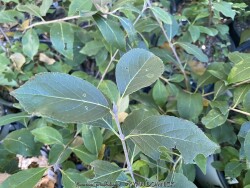

***Shrub descriptions available with future update!***Blackhaw Native Viburnum, is also known as Viburnum prunifolium


***Shrub descriptions available with future update!***Rusty Blackhaw Native Viburnum, is also known as Viburnum rufidulum
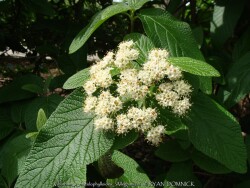

Leatherleaf viburnum is a large semi-evergreen shrub with leathery leaves and cream white flowers. Foliage emerges light green with powdery white material on the backside of the leaf. Foliage darkens to a medium green by summer and finally turning to a purplish winter color. About half of the foliage drops in the winter but is still effective enough for a partial screening. Flowers bloom mostly in spring but sporadically throughout the year. If pollination occurs, red fruits follow in the late summer thru fall creating quite a show. More than one variety is typically required for pollination. Leatherleaf viburnum prefers medium to rich garden soil in full to part sun. Being one of the toughest viburnums around, it can handle much less than ideal conditions including dry shade. Typically our are 40 inches of rainfall per year in eastern Kansas is enough without extra water. However, during times of drought, the foliage will wilt and growth will stop. Luckily the foliage is able to survive in a wilted state for a long time (usually up to two or three weeks) before actually dying. This gives you plenty of notice that it needs water. There is virtually no maintenance except rejuvenation on very old plants. Yearly fertilizer application is appreciated. When given plenty of room to grow, Leatherleaf Viburnum can reach up to 8 or 12 feet tall and wide after 20-30 years. Eventually old canes become unproductive and should be removed allowing young vigorous canes to develop. Leatherleaf viburnum grows slow at first especially in rough soils but the key thing is that it will survive and grow faster when established. Cold hardiness is not a problem in Lawrence Kansas zone 6a but in colder climates expect winterkill down to the ground in some years. Considered one of the best plants for solving your most difficult dry-shade landscape challenges. Several improved cultivars exist. Alleghany Leatherleaf Viburnum (Viburnum x rhytidophylloides 'Alleghany') has improved cold hardiness and growth form.


Leatherleaf viburnum is a large semi-evergreen shrub with leathery leaves and cream white flowers. Foliage emerges light green with powdery white material on the backside of the leaf. Foliage darkens to a medium green by summer and finally turning to a purplish winter color. About half of the foliage drops in the winter but is still effective enough for a partial screening. Flowers bloom mostly in spring but sporadically throughout the year. If pollination occurs, red fruits follow in the late summer thru fall creating quite a show. More than one variety is typically required for pollination. Leatherleaf viburnum prefers medium to rich garden soil in full to part sun. Being one of the toughest viburnums around, it can handle much less than ideal conditions including dry shade. Typically our are 40 inches of rainfall per year in eastern Kansas is enough without extra water. However, during times of drought, the foliage will wilt and growth will stop. Luckily the foliage is able to survive in a wilted state for a long time (usually up to two or three weeks) before actually dying. This gives you plenty of notice that it needs water. There is virtually no maintenance except rejuvenation on very old plants. Yearly fertilizer application is appreciated. When given plenty of room to grow, Leatherleaf Viburnum can reach up to 8 or 12 feet tall and wide after 20-30 years. Eventually old canes become unproductive and should be removed allowing young vigorous canes to develop. Leatherleaf viburnum grows slow at first especially in rough soils but the key thing is that it will survive and grow faster when established. Cold hardiness is not a problem in Lawrence Kansas zone 6a but in colder climates expect winterkill down to the ground in some years. Considered one of the best plants for solving your most difficult dry-shade landscape challenges. Several improved cultivars exist. Darts Duke Leatherleaf Viburnum (Viburnum x rhytidophylloides 'Dart's Duke') features larger dark green foliage, larger flowers, better density, and pink cottony flock on the back of new leaves and new stems instead of white. All Proven Winners® plants are legally propagated, healthy and vigorous, true to name, and tagged with color pictures and growing information.
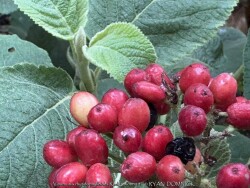

Leatherleaf viburnum is a large semi-evergreen shrub with leathery leaves and cream white flowers. Foliage emerges light green with powdery white material on the backside of the leaf. Foliage darkens to a medium green by summer and finally turning to a purplish winter color. About half of the foliage drops in the winter but is still effective enough for a partial screening. Flowers bloom mostly in spring but sporadically throughout the year. If pollination occurs, red fruits follow in the late summer thru fall creating quite a show. More than one variety is typically required for pollination. Leatherleaf viburnum prefers medium to rich garden soil in full to part sun. Being one of the toughest viburnums around, it can handle much less than ideal conditions including dry shade. Typically our are 40 inches of rainfall per year in eastern Kansas is enough without extra water. However, during times of drought, the foliage will wilt and growth will stop. Luckily the foliage is able to survive in a wilted state for a long time (usually up to two or three weeks) before actually dying. This gives you plenty of notice that it needs water. There is virtually no maintenance except rejuvenation on very old plants. Yearly fertilizer application is appreciated. When given plenty of room to grow, Leatherleaf Viburnum can reach up to 8 or 12 feet tall and wide after 20-30 years. Eventually old canes become unproductive and should be removed allowing young vigorous canes to develop. Leatherleaf viburnum grows slow at first especially in rough soils but the key thing is that it will survive and grow faster when established. Cold hardiness is not a problem in Lawrence Kansas zone 6a but in colder climates expect winterkill down to the ground in some years. Considered one of the best plants for solving your most difficult dry-shade landscape challenges. Several improved cultivars exist. Red Balloon Leatherleaf Viburnum (Viburnum x rhytidophylloides 'Red Balloon') features significant improvements. In spring, large, lacy white flower clusters cover the plant, followed by green fruit which turns brilliant red in late summer. The thick, leathery foliage lends a distinguished, handsome look to the plant all season. This viburnum will develop some berries without another variety as a pollinator, but you'll get more fruit if planted around 'Mohican' or 'Alleghany.' Proven Winners® plants are legally propagated, healthy and vigorous, true to name, and tagged with color pictures and growing information.
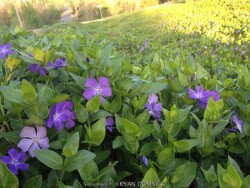

***Description for this perennial available with future update!***Vinca Major / Periwinkle, is also known as Vinca major
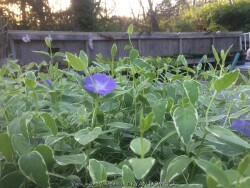

***Description for this perennial available with future update!***Variegated Vinca Major, is also known as Vinca major 'Variegata'
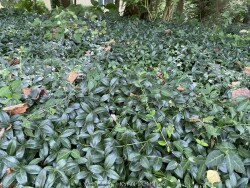

Vinca Minor / Periwinkle is an evergreen groundcover native to central and southern Europe but naturalized and has become invasive in parts of North America. The evergreen leaves are a glossy dark green with a leathery texture. The 5-petal violet-purple flowers are produced mainly from early spring to mid summer but with a few flowers still produced into the autumn. Landscape uses include small scale groundcovers and hillside areas in full to part shade. In full sun, foliage burn occurs in late summer and with slow recovery, weeds find an opportunity to invade. Due to slow spreading growth in our Kansas climate, you shouldn't leave very much room in-between vinca plants or you will be waiting many years for the patch to fill in. Weeds can again be a problem in that open area between plants if spacing is too wide. We recommend 9-12" spacing and use for small nooks in the shade garden. If planning for a larger area, still figure on the tight spacing but allow for a higher budget that you will consider a permanent investment. However, a serious vine stem canker (blight / disease), limits its use in our area and can damage or kill large patches. Good air circulation and limiting night-time irrigation can reduce the prevalence of this disease. Generally this plant declines after a few years of Kansas climate but worth a try in perfect soils in well-tended shade gardens. The canker disease and competition with weeds seem to be an issue. Roundup effectively eraticates patchy leftover remnant growth after disease runs its course when clearing the area for better groundcover species.
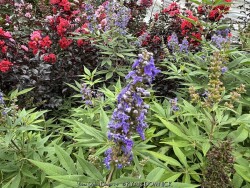

Description from First Editions: Delta Blues™ Chastetree is an intermediate sized shrub that has fragrant, dark blue-purple flowers that attract butterflies and other pollinators. Dark green, fragrant leaves contrast against the colorful flowers that bloom from June to October. Delta Blues™ is deer resistant, salt tolerant, and adapts to acid or alkaline soils as long as the site is well drained. Fun fact: Delta Blues™ was the first intermediate Vitex in the market!
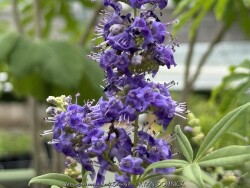

Vitex agnus-castus 'Rock Steady' is a new breakthrouth in the market. In Eastern Kansas, this cultivar performs WELL with just about everything nature has to challenge it! Extreme heat and drought are tolerated. Cold tolerance is no problem in our zone 6. If winter die-back occurs, cut back in March/April and flowers will occur on new growth this year. No disease or pest problems. Great plant for berms, hot West or South exposures, and most any other garden situations in full sun. Will tolerate clay soils and extra moisture in summer. Combine with caryopteris, crapemyrtle, and butterflybush to create a late season "all you can eat" buffet for pollinators!
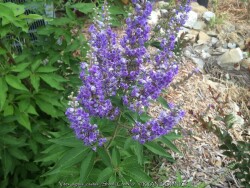

Vitex agnus-castus 'Shoal Creek' is also known as Shoal Creek Vitex / Chastetree. In Eastern Kansas, this cultivar performs WELL with just about everything nature has to challenge it! Extreme heat and drought are tolerated. Cold tolerance is no problem in our zone 6. If winter die-back occurs, cut back in March/April and flowers will occur on new growth this year. No disease or pest problems. Great plant for berms, hot West or South exposures, and most any other garden situations in full sun. Will tolerate clay soils and extra moisture in summer. Combine with caryopteris, crapemyrtle, and butterflybush to create a late season "all you can eat" buffet for pollinators! According to our supplier, this PROVEN WINNERS selection of vitex is incredibly long-blooming - 6-16 weeks longer than six other popular varieties of vitex, according to our trials. Sprays of beautiful lavender flowers grace the plant from late spring through fall, attracting pollinators and fending off heat, drought, and deer like it was born to do it. It is, of course, heat tolerant, but also surprisingly hardy.
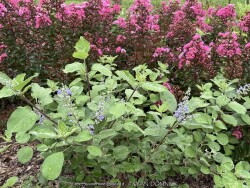

Description from plant breeder, Plant Nouveau: "This new hybrid vitex breaks all of the rules! Selected from a batch of vitex crosses made by former V.P. of Horticulture, Kris Jarantoski of the Chicago Botanic Garden, Summertime Blues has a rounded habit with exceptionally large individual flowers held on black stems. Just imagine a vitex with improved hardiness, that flowers most of the summer and can be used as a shrub…and you have Summertime Blues! Undisputedly an improved selection, Summertime Blues offers multi-season interest for gardens from California to Chicago and even in the deep south. Extreme drought tolerance, a more manageable size, and sterile flowers make the perfect combination for this work horse, easy-to-care-for shrub. Note: This plant has produced no viable seed for the past 15 years and therefore should not have the invasive tendencies of Vitex rotundifolia, which is one of its parents." Vitex agnus castus x rotundifolia ‘Helen Froehlich’ PP31660, Summertime Blues™ is quite a mouthful to say but well worth it in the landscape. We are testing the claims that it may be winter hardy as a shrub with less die back in our Lawrence, KS zone 6a display garden. This is the first year of texting...2024! We will keep you posted.